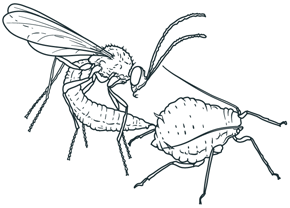
 |
|
Hydroponics - Indoor HorticultureHydroponics - Indoor Horticulture represents an educational, in-depth,
up-to-date,
indoor horticultural growers guide that covers all principles of indoor Hydroponics - Indoor Horticulture examines, explores, dissects and
presents a fully comprehensive step by step growers guide, relating
to all and every aspect of indoor hydroponic horticulture, with complete
chapters on plant biology, propagation, hydroponic systems, nutrients,
oxygen, carbon dioxide enrichment, pH, biological pest control, fungi/disease,
cuttings/clones, pruning/training, breeding, harvesting, equipment,
grow rooms, a full history of hydroponics, and more. |
(Below
follows a one page sample taken from the book) Aphidoletes is a small and slender midge
measuring 2 mm in length and has long legs. The males possess long grey
antennae whereas those of the female are shorter and darker in colour.
Usually visible are the larvae which are orange or orange red grubs
that resemble maggots. When fully grown, these are 3 mm in length and
the body narrows at both ends. They can be found in aphid colonies.
Life CycleAphidius is a parasite and lays an egg into an undeveloped aphid. This happens very quickly and takes just a few seconds. The egg hatches after enlarging quite significantly as the larva matures inside the aphid. The aphid is destroyed when the larva reaches adulthood. When the larva is fully grown, which is very obvious, as the aphid becomes bloated and typically turns a metallic brown colour. The dead aphid is anchored to the leaf with a silk thread by the parasite and the larva spins a cocoon inside the aphid. It eventually emerges from the cocoon as an adult wasp via a circular hole which is visible in the back of the aphid. The entire process takes approximately 3 weeks at 20°C and a single female parasite can produce up to 100 eggs in her lifetime.  |
Aphidoletes is a midge which produces a predatory larva. These feed on aphids in order to develop and reach adulthood. The adult midges subsist on honeydew from plants that are infested by aphids, and are active in the early evenings and throughout the night. During daylight hours, they are immobile and stay in the shade. Eggs are laid on the underside of leaves, but only on aphid infested plants, and they can lay about 100 eggs during their relatively short lifespan which lasts approximately a week. The eggs measure between 0.3 mm by 0.1 mm and are an orange colour and after a couple of days, small orange coloured larvae are hatched. The larvae are voracious and must start eating aphids within a few hours of hatching. They can detect aphids over fairly large distances. Aphidoletes larvae poison aphids, which paralyses them before they die. This poison liquifies the body contents of the aphid after death and the larvae can then suck the body fluids out of the aphid. More aphids are destroyed than actually consumed, particularly if the aphids are big. The fully matured larva then makes its way down the plant or falls to the ground and then tunnels 2-3 mm into the soil, where it spins a cocoon of sticky threads coated in soil debris. The larva starts to pupate after a few days. If the day is less than 15 hours long, the larvae do not pupate straightaway, but remain in a state of suspended animation. In nature, this would occur in September, and the larva would then complete their development in the spring. |
|
 |